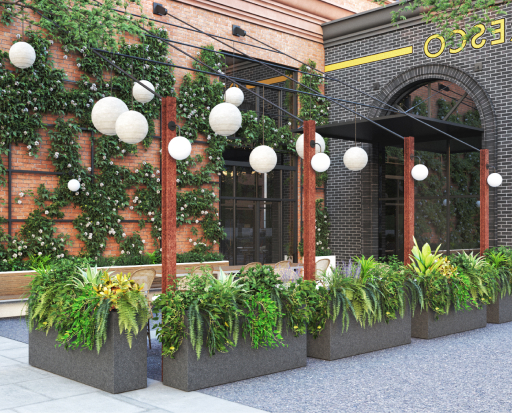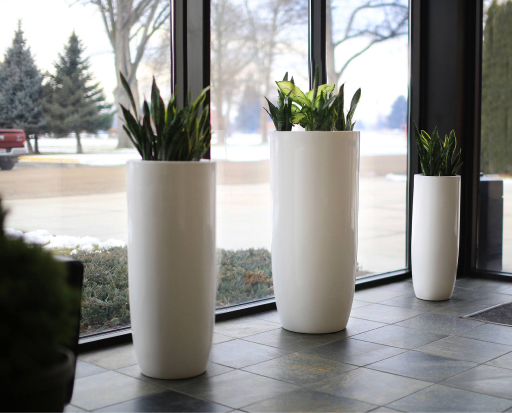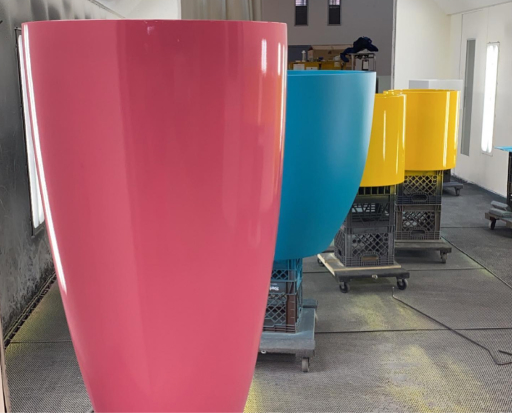Planters for Rooftop Gardens
Rooftop gardens are no longer just novel amenities; they’ve become essential features in urban development—especially for residential high-rises, corporate offices, hotels, and even educational facilities.
By integrating green spaces above street level, property owners and managers can create serene retreats that enhance both the building’s aesthetic and its sustainability profile. At the same time, rooftop environments pose unique challenges: structural load limits, direct exposure to the elements, and the need to optimize every square foot of available space.
These factors make fiberglass planters an ideal solution. Lightweight yet remarkably durable, fiberglass planters offer the flexibility and resilience necessary for rooftops of any shape or size.
Ready to transform your rooftop into a functional and beautiful garden?
Key Uses of Rooftop Garden Planters
Perimeter Edging & Wind Breaks
One of the most straightforward ways to elevate your rooftop design is by placing rooftop planter boxes along the perimeter. This approach serves two crucial purposes: it visually softens hard architectural lines while creating a natural wind buffer.
For facilities exposed to high winds or seeking to enhance safety, tall plants in fiberglass planters act as windbreaks without blocking rooftop views.
✔️ Increased Safety & Aesthetics: Fiberglass trough planters can be arranged around the edges to form subtle barriers that keep people safely away from parapet edges.
✔️ Ornamental Grasses & Shrubs: Tall ornamental grasses such as Miscanthus or feather reed grass help disrupt wind flow, sparing you from the need to install solid walls.
Zoning for Seating & Entertaining
Rooftop gardens are prized not just for greenery but also for the social opportunities they create. Facilities often want to delineate separate areas for lounging, dining, and open space but don’t necessarily want permanent structures that could limit future flexibility.
✔️ Defined Spaces, No Construction: By placing modular lightweight rooftop planters strategically, you can subtly guide foot traffic and section off different activity zones—no walls or major installations needed.
✔️ Low-Profile Divisions: Rectangular, low-profile planters are perfect for dividing seating areas while keeping sightlines open.
Urban Farming & Edible Gardens
The concept of “farm-to-table” isn’t limited to restaurants or rural areas anymore. A growing number of commercial and residential properties are transforming rooftops into productive vegetable, herb, and even fruit gardens.
This approach reduces the carbon footprint associated with transporting fresh produce while also creating a unique amenity that engages the local community.
✔️ Space for Edibles: Choose planters that are deep and wide enough to accommodate the root systems of vegetables and dwarf fruit trees.
✔️ Efficient Drainage: Rooftop environments are often exposed to extreme rainfall or harsh sun. With built-in drainage systems in fiberglass planters, you can maintain consistent soil conditions for healthy plant growth.
Aesthetic Focal Points
Finally, rooftop planters can also serve as design statements. When chosen carefully, certain planter styles and bold plantings can create stunning focal points that draw the eye and lend a sense of drama to the space.
✔️ Seasonal Splendor: Use planters for rooftop gardens filled with colorful flowers or unique foliage to keep your rooftop visually appealing year-round.
✔️ Sculptural Shapes: Fiberglass planters are available in myriad silhouettes and finishes—from sleek cylinders to geometric forms—that allow you to harmonize or contrast with the building’s architecture.
Benefits of Fiberglass Planters for Rooftop Gardens
Lightweight
Rooftops demand careful attention to weight limits. Fiberglass weighs significantly less than materials like concrete or ceramic, reducing strain on building structures.
Durable
High-quality fiberglass withstands daily wear, heavy foot traffic, and even severe weather conditions. It won’t rust or corrode, making it a longer-lasting choice for open-air environments.
Weather-Resistant
Rooftop conditions can be unforgiving, with glaring sun, strong winds, and rapid temperature shifts. Fiberglass planters resist cracking, fading, or warping—ensuring they look great for years.
Custom Drainage Options
Healthy plants require proper drainage. Fiberglass planters are easy to drill or fit with drain holes, and many models can accommodate self-watering or drip irrigation systems. In our shop, you have the option to order rooftop garden planters with or without drainage holes.
Fully Customizable
Facility managers and designers often have unique color palettes or design schemes in mind. Our fiberglass rooftop planters are available in a wide array of finishes and hues , making it simple to match or contrast with existing décor.
Low Maintenance
Maintenance staff will appreciate that fiberglass planters rarely need more than a quick wipe-down. They don’t chip or peel easily, so they maintain their appearance with minimal effort.








